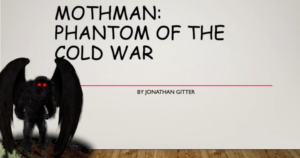In mid-November, 1966, in the small town of Point Pleasant, West Virginia, two young couples fled the local woods, claiming they’d seen a terrifying creature. They recounted their story to the sheriff and reported that the entity looked human in most respects – except for its 10-foot wings and glowing red eyes.
The local paper ran the story of the ‘Mothman.’ Within a day or two, the whole town descended on the location where the creature was reported, toting guns and ready to hunt it down. They didn’t find it, but they did spark a legend.
How did the Mothman go from a local myth to an internationally-recognized figure, similar to Bigfoot and the Loch Ness Monster?
Great question. Jonathan Gitter is glad you asked.
Gitter just finished his major in history at UWM and graduated in May. His capstone research project tackled the Mothman myth, and he presented his work at UWM’s virtual Undergraduate Research Symposium in late April.
Initially, Gitter and his classmates were told their capstone project had to cover “non-human” history.
“My first thought was to do something with cryptids or various mythological creatures,” he said. “I looked at, where does this Mothman myth come from?”
Unlike Bigfoot, the Mothman myth has a definitive start date and location. After the initial report by the two young couples in West Virginia, newspapers in the area began to run with the story. That was where Gitter began his research.
“I looked at … newspaper articles, and then I looked at books that were written on the topic,” he said. “(There was) Ufologist John Keel’s book The Mothman Prophecies, and then I looked into, more recently, the media that’s constructed around the Mothman myth – various documentaries and the Point Pleasant Mothman Festival .”
Through his research, Gitter uncovered far more than the cryptid’s origins: He found a snapshot of small-town Americana built into the fabric of the myth.
Take, for example, the area of Point Pleasant where the Mothman was first sighted. According to Gitter’s research, that spot was known as the “TNT area,” so named for the factories that used to produce explosives for use during World War II. After the war, the factories were abandoned and the area grew over, despite the fact that TNT was reportedly still being stored on site and contaminating the local environment.
“Once the news came out about possible environmental pollution (people began to speculate) if this thing was irradiated,” Gitter said. “It was more of a retroactive assignment than in the initial sightings.”
The myth may have also benefited from the time period’s fascination with aliens and UFOs, which itself was possibly born out of Cold War fears.
“I definitely do think there’s an element of some Cold War-era watching the skies and looking for UFOs and things of that nature,” Gitter said. “In the article about the first sightings, one of the witnesses says specifically, ‘This wasn’t a UFO.’ So I think that it relates in that sense.”
Against that backdrop, the Mothman myth was poised to take flight.
“There was a series of sightings by people all over Pt. Pleasant, and then it slowly moved outward. Eventually, there were Mothman sightings in other places in the United States and also internationally. … I heard briefly about some sightings in Russia,” Gitter said.
But sightings in Point Pleasant stopped after a tragedy, he added. In 1967, a year after the initial sighting, the Silver Bridge, a major route in and out of the town, collapsed, killing upwards of 40 people. Afterward, people began to claim they had seen the Mothman standing on the bridge the day before, possibly as an omen of the disaster to come.
Even so, the town has embraced its legend; the annual Mothman Festival in Point Pleasant draws in more tourists than the town’s actual population. It also boasts a Mothman Museum , and a statue of the figure stands prominently downtown.
The history of the urban legend was fascinating for Gitter to uncover, but it also made him ponder myths beyond their history. How do people come up with these myths, and what purpose do they serve?
“To be clear, I don’t think Mothman is real, but I do think there is a combination of motivators for people who report these sightings. There are people who saw something and it’s unclear what they saw. I’m sure there are people who report seeing these things for the attention, and there are people in between,” Gitter said. “I wouldn’t be surprised if one of the motivators for the spread and incubation of this myth is the small town – everybody knows everybody and hears something interesting. Eventually, following the collapse of the Silver Bridge, it became ‘here’s meaning to why something bad happened.’ Then it eventually became an economic draw for this small town.”
The Mothman Festival is Sept. 18-19, 2021. If you go, just try to stay out of the TNT area. You never know what creatures may be lurking.
By Sarah Vickery, College of Letters & Science
